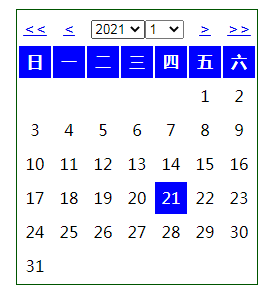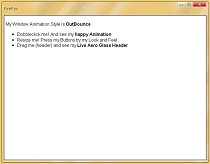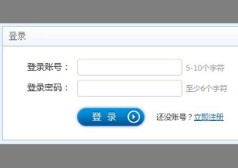详解如何用PHP制作一个简单的日历
3140
本篇文章给大家带来了关于PHP的相关知识,其中主要跟大家介绍怎么用PHP制作一个简单的日历,感兴趣的朋友下面一起来看一下吧,希望对大家有帮助。
实例说明
说到对日期和时间的处理,就一定要介绍一下日历程序的编写。但一提起编写日历,大多数读者都会认为日历的作用只是为了在页面上显示当前的日期,其实日历在我们的开发中有着更重要的作用。例如,我们开发一个“记事本”就需要通过日历设定日期,在一些系统中需要按日期去安排任务也需要日历,等等。
实现过程
将日历类 Calendar 声明在文件 calendar.class.php中,代码如下所示:
- <?php
- /*
- calendar.class.php日历类
- 声明一个日历类,名称为Calendar,用来显示可以设置日期的日历
- */
- class Calendar{
- private $year;//当前的年
- private $month;//当前的月
- private $start_weekday;//当月的第一天对应的是周几,作为当月遍历日期的开始
- private $days;//当前月的总天数
- /**
- * 构造方法,初始化一些属性
- */
- function __construct(){
- //如果用户没有设置年份数,则使用当前系统时间的年份
- $this->year = isset($_GET["year"]) ? $_GET["year"] :date("Y") ;
- //如果用户没有设置月份数,则使用当前系统时间的月份
- $this->month = isset($_GET["month"]) ? $_GET["month"] :date("m") ;
- //通过具体的年份和月份,利用date() 函数的w参数获取当月第一天对应的是周几
- $this->start_weekday = date("w",mktime(0, 0, 0, $this->month, 1, $this->year));
- //通过具体的年份和月份,利用date()函数的参数获取当月的天数
- $this->days = date("t",mktime(0, 0, 0, $this->month, 1, $this->year));
- }
- /**
- * 打印整个日历
- * @return string 日历字符串
- */
- function __toString(){
- $out .= '<table align="center">'; //日历以表格形式打印
- $out .= $this->changeDate(); //用户设置日期
- $out .= $this->weeksList(); //打印·周·列表
- $out .= $this->daysList(); //打印·日·列表
- $out .= '</table>'; //表格结束
- return $out; //返回整个日历,输出需要的全部字符串
- }
- /**
- * 输出周列表
- * @return string 周列表字符串
- */
- private function weeksList(){
- $week = array ('日','一','二','三','四','五','六');
- $out .= '<tr>';
- for($i = 0; $i < count($week); $i++){
- $out .= '<th class="fontb">' . $week [$i]. '</th>';
- }
- $out .= '</tr>';
- return $out; // 返回周列表字符串
- }
- /**
- * 输出日列表
- * @return string 日历表字符串
- */
- private function daysList(){
- $out .= '<tr>';
- // 输出空格(当月第一天对应的是周几,就是几个空格)
- for($j = 0; $j < $this->start_weekday; $j++){
- $out .= '<td> </td>';
- }
- // 循环输出当前月所有日期
- for($k = 1; $k <= $this->days; $k++){
- $j++;
- if($k == date('d')){// 若为当前日期,设置为深色背景
- $out .= '<td class="fontb">'.$k.'</td>';
- } else {
- $out .= '<td>'.$k.'</td>';
- }
- if($j%7 == 0){//每输出7个日期,就换一行
- $out .= '</tr><tr>';//输出行结束和下一行开始
- }
- }
- while ($j%7 != 0) {//遍历完日期后,剩下的用空格补全
- $out .= '<td> </td>';
- $j++;
- }
- $out .= '</tr>';
- return $out; //返回当月日列表
- }
- /**
- * 用于处理当前年份的上一年需要的数据
- * @param int $year 当前年份
- * @param int $month 当前月份
- * @return string 最终的年份和月份设置参数
- */
- private function prevYear($year, $month){
- $year = $year-1; //上一年是当前年减1
- if ($year < 1970){ //如果设至的年份小于1970年
- $year = 1970; //年份设置最小值是1970年
- }
- //返回最终的年份和月份设置参数
- return "year={$year}&month={$month}";
- }
- /**
- * 用于处理当前月份的上一月份的数据
- * @param int $year 当前年份
- * @param int $month 当前月份
- * @return string 最终的年份和月份设置参数
- */
- private function prevMonth($year, $month){
- if($month== 1){
- $year = $year -1;
- if($year < 1970){ // 最小年份数不能小于1970年
- $year = 1970;
- }
- //如果月是1月,上一月就是上一年的最后一月
- $month = 12;
- } else {
- $month--; //上一月就是当前月减1
- }
- // 返回最终的年份和月份设置参数
- return "year={$year}&month={$month}";
- }
- /**
- * 用于处理当前年份的下一年份的数据
- * @param int $year 当前年份
- * @param int $month 当前月份
- * @return string 最终的年份和月份设置参数
- */
- private function nextYear($year, $month){
- $year = $year+1; // 下一年是当前年加1
- if ($year> 2038){ //如果设量的年份大于2038年
- $year=2038; //最大年份不能超过2038年
- }
- //返回最终的年份和月份设置参数
- return "year={$year}&month={$month}";
- }
- /**
- * 用于处理当前月份的下一个月份的数据
- * @param int $year 当前年份
- * @param int $month 当前月份
- * @return string 最终的年份和月份设置参数
- */
- private function nextMonth($year, $month){
- if($month == 12){//如果已经是当年的最后一个月
- $year++;//下一个月就是下一年的第一个月,让年份加1
- if($year> 2038){ //如果设豆的年份大于2038年
- $year = 2038; //最大年份不能超过2038年
- }
- $month = 1; //设置月份为下一年的第一个月
- } else {
- $month++;//其他月份的下一个月都是当前月份加1即可
- }
- //返回最终的年份和月份设置参数
- return "year={$year}&month={$month}";
- }
- /**
- * 调整日期
- * @param string $url 页面路径
- * @return string 页面字符串
- */
- private function changeDate($url='index.php'){
- $out .= '<tr>';
- //上一年
- $out .= '<td><a href="'.$url.'?'.$this->prevYear($this->year,$this->month).'">'.'<<'.'</a></td>';
- //上个月
- $out .= '<td><a href="'.$url.'?'.$this->prevMonth($this->year,$this->month).'">'.'<'.'</a> </td>';
- $out .= '<td colspan="3">';
- $out .= '<form>';
- //年份选择框
- $out .= '<select name="year" οnchange="window.location=\''. $url.'?year=\'+this.options[selectedIndex].value+\'&month='. $this->month. '\'">';
- //循环输出年份
- for($sy=1970; $sy <= 2038; $sy++){
- $selected = ($sy==$this->year) ? "selected" : "";
- $out .= '<option '. $selected. ' value="'. $sy. '">'. $sy. '</option>';
- }
- $out .= '</select>';
- //月份选择框
- $out .= '<select name="month" οnchange="window.location=\''. $url. '?year='. $this->year. '&month=\'+this.options[selectedIndex].value">';
- //循环输出月份
- for ($sm=1; $sm <=12; $sm++){
- $selected1 = ($sm==$this->month) ? "selected" : "";
- $out .='<option '. $selected1. ' value="'. Ssm. '">'. $sm. '</option>';
- }
- $out .= '</select>';
- $out .= '</form>';
- $out .= '</td>';
- //下一年
- $out .= '<td> <a href="'.$url.'?'.$this->nextMonth($this->year,$this->month).'">'.'>'.'</a></td>';
- //下个月
- $out .= '<td> <a href="'.$url.'?'.$this->nextYear($this->year,$this->month).'">'.'>>'.'</a></td>';
- $out .= '</tr>';
- return $out; //返回调整日期的表单
- }
- }
本例将一个日历程序按功能拆分(周列表部分、日期列表部分、设置日期部分,以及上一年、下一年、上一月和下一月的设置部分)并封装在一个日历类中。有了日历类,我们还需要编写一个主程序去加载并输出日历。在主程序中还需要先设置一下日历输出的样式,代码如下所示:
- <!DOCTYPE html>
- <html>
- <head>
- <meta charset="UTF-8">
- <meta name="viewport" content="width=device-width, initial-scale=1.0">
- <title>日历示例</title>
- <style>
- table{ border: 1px solid #050; }
- .fontb{ color:white;background:blue; }
- th { width: 30px; }
- td,th { height: 30px;text-align:center; }
- form { margin: 0px;padding: 0px; }
- </style>
- </head>
- <body>
- <?php
- require 'calendar.class.php';
- echo new Calendar;
- ?>
- </body>
- </html>
效果展示
运行效果如下如所示:

本文网址:https://www.zztuku.com/detail-14005.html
站长图库 - 详解如何用PHP制作一个简单的日历
申明:本文转载于《CSDN》,如有侵犯,请 联系我们 删除。
















您还没有登录,请 登录 后发表评论!
提示:请勿发布广告垃圾评论,否则封号处理!!